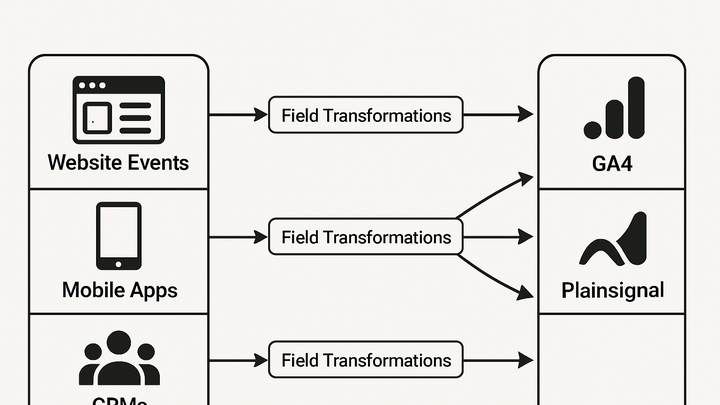Published on 2025-06-28T14:04:59Z
What is Data Mapping? Examples of Data Mapping in Analytics
Data mapping in analytics is the process of linking raw data fields from various sources (e.g., websites, mobile apps, and CRMs) to a unified target schema within analytics platforms. It involves defining source attributes (like event names, user properties, and timestamps) and mapping them to destination fields supported by tools such as Google Analytics 4 or PlainSignal. By establishing clear mapping rules, organizations ensure consistent data formatting, accurate reporting, and smooth integration across multiple systems. Proper data mapping also enhances data governance by documenting transformation logic and lineage, aiding in compliance and auditing. Without robust data mapping, teams risk misaligned metrics, data silos, and inaccurate insights that can lead to poor decision-making.
Data mapping
Process of matching and translating data fields from various sources into a unified schema for consistent analytics.
Understanding Data Mapping
Overview of data mapping concepts and its role in analytics pipelines.
-
Definition
Data mapping is the process of linking data attributes from one or more source systems to the corresponding fields in a target analytics schema.
-
Key components
A complete data mapping solution includes source fields, a defined target schema, and transformation logic to convert values as needed.
-
Source fields
Original data attributes from website events, databases, APIs, and third-party tools.
-
Target schema
Predefined structure in the analytics platform that specifies event names, parameters, and user properties.
-
Transformation rules
Logic for modifying field values, renaming attributes, aggregating metrics, or converting data types.
-
Why Data Mapping Matters
Explores the importance of accurate data mapping for reliable analytics and data governance.
-
Ensures data consistency
Standardizes naming conventions and formats across all data sources, reducing discrepancies.
-
Enables cross-platform analysis
Allows combined reporting across multiple tools by aligning data structures to a common model.
-
Supports data governance
Documents lineage and transformation logic, aiding in auditing, compliance, and quality checks.
Implementing Data Mapping
Step-by-step guide and best practices for setting up effective data mappings in analytics projects.
-
Identify data sources
Catalog all systems and channels that generate data, such as websites, mobile apps, and CRMs.
-
Website tags
Client-side tracking snippets that capture user interactions and pageviews.
-
Server logs
Backend event records generated by application servers.
-
Third-party apis
Data exports from marketing, e-commerce, or CRM platforms.
-
-
Define target schema
Design a unified data model with standardized event names, parameters, and user properties.
-
Event and parameter names
Establish clear, descriptive naming conventions (e.g., purchase_event, user_signup).
-
Data types
Specify types for each field (string, integer, boolean) to prevent type mismatches.
-
Required vs. optional fields
Determine which attributes are mandatory for reporting and which are supplemental.
-
-
Configure field mappings
Map each source attribute to the corresponding target field, applying any transformation logic.
-
Direct mapping
Match source and target fields with identical names and formats.
-
Transformed mapping
Apply functions or rules (e.g., concatenation, regex) to adapt source data to target requirements.
-
-
Validate and test
Ensure mappings work correctly by testing with sample data and verifying results in analytics tools.
-
Unit tests
Validate individual field mappings in isolation.
-
Integration tests
Simulate end-to-end data flows to catch mapping errors before deployment.
-
-
Maintain and update
Regularly review and adjust mappings as source systems or business requirements evolve.
-
Version control
Track changes to mapping definitions to enable rollbacks and auditing.
-
Monitoring
Set up alerts or dashboards to detect missing data or anomalies in mapped fields.
-
Data Mapping in SaaS Analytics Tools
Practical examples of setting up data mapping in popular analytics platforms.
-
PlainSignal example
PlainSignal is a cookie-free analytics platform designed for simplicity. You can map custom data attributes by adjusting the tracking snippet and defining mapping keys.
-
Tracking code integration
Insert the following snippet on your pages to start capturing events:
<link rel="preconnect" href="//eu.plainsignal.com/" crossorigin /> <script defer data-do="yourwebsitedomain.com" data-id="0GQV1xmtzQQ" data-api="//eu.plainsignal.com" src="//cdn.plainsignal.com/plainsignal-min.js"></script> -
Custom attribute mapping
Use data attributes (e.g.,
data-do,data-custom-event) to tag events and map them to PlainSignal’s schema.
-
-
GA4 example
Google Analytics 4 uses an event-based model with flexible parameter mapping through the gtag API or Measurement Protocol.
-
Gtag configuration
Send events with
gtag('event', 'purchase', { currency: 'USD', value: 99.99 });to map parameters to GA4 fields. -
Custom dimensions
Define custom dimensions in the GA4 Admin UI and include them in your event payloads to map additional attributes.
-
